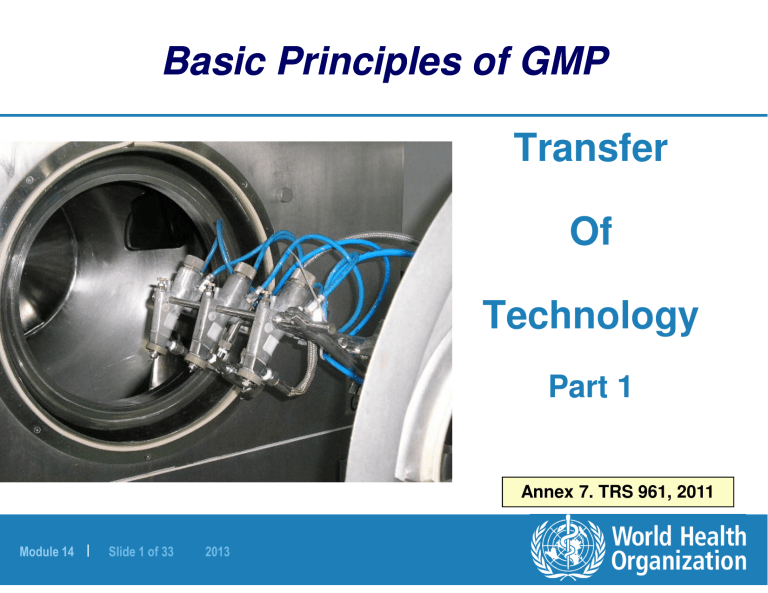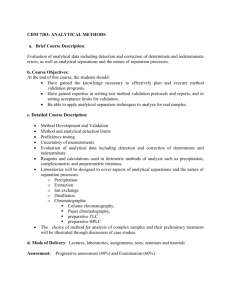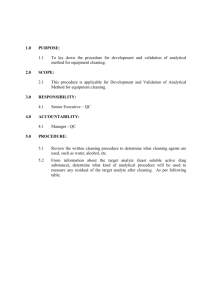Basic Principles of GMP Transfer Of Technology
advertisement

Basic Principles of GMP Transfer Of Technology Part 1 Annex 7. TRS 961, 2011 Module 14 | Slide 1 of 33 2013 Transfer of Technology Introduction Organization and management Premises and equipment Quality control: analytical method transfer Production: Processing, packaging and cleaning – Qualification and validation Documentation Module 14 | Slide 2 of 33 2013 Transfer of Technology Guideline – provides guidance – in addition to GMP Product may be transferred during: – Development – Scale up – Commercial baatches - Site transfer (various possibilities) TOT defined as “a logical procedure that controls the transfer of any process together with its documentation and professional expertise between development and manufacture or between manufacturing sites”. 1.1 – 1.2 Module 14 | Slide 3 of 33 2013 Transfer of Technology Transfer includes: – Documentation and ability – Knowledge and experience Systematic process Documented plan – in a quality system Development, Production and QC 1.2 – 1.5 SU and RU Module 14 | Slide 4 of 33 2013 Transfer of Technology Successful transfer needs: Project plan covering quality aspects – based on quality risk management SU and RU to have similar capabilities, facilities and equipment Technical gap analysis is done – technical risk assessment and potential regulatory gaps – effective process and product knowledge transfer 1.6 Trained staff Module 14 | Slide 5 of 33 2013 Transfer of Technology Problems communicated from RU to SU Continuing knowledge management Legal and economic implications – intellectual property rights, royalties, pricing, conflict of interest and confidentiality Transparent process Success: Documented evidence that the RU routinely reproduces the transferred product, process or method 1.7 – 1.12 against a predefined set of specifications as agreed with SU Module 14 | Slide 6 of 33 2013 Transfer of Technology Scope: Covers production and quality control All dosage forms - adjusted case-by-case basis (e.g. by using risk management principles). Technical agreement to be in place – Particularly close control to sterile products, and metered dose aerosols Production – active pharmaceutical ingredients (APIs), – manufacturing and packaging of bulk materials, – manufacturing and packaging of finished pharmaceutical products (FPPs) 2.1 – 2.2 – analytical testing Module 14 | Slide 7 of 33 2013 Transfer of Technology Covers: Transfer of development and production (processing, packaging and cleaning) Transfer of analytical methods for quality assurance and quality control Skills assessment and training Organization and management of the transfer Assessment of premises and equipment Documentation; and qualification and validation Module 14 | Slide 8 of 33 2013 2.4 Transfer of Technology Organization and management Takes place between an SU and an RU (Another party may be involved coordinating / approving) Formal agreement – responsibilities before, during and after transfer Project management plan – identifies and controls all the necessary activities Module 14 | Slide 9 of 33 2013 4.1 – 4.4 Transfer of Technology Transfer protocol to include: Objective and scope Key personnel and their responsibilities A parallel comparison of materials, methods and equipment Transfer stages Identification of critical control points Experimental design and acceptance criteria for analytical methods Module 14 | Slide 10 of 33 2013 4.5 Transfer of Technology Transfer protocol to include: (2) Information on trial production batches, qualification batches and process validation; Change control and deviations encountered; Assessment of end-product; Arrangements for keeping retention samples Conclusion and approval 4.5 Module 14 | Slide 11 of 33 2013 Transfer of Technology SU should provide: Validation documentation from SU (normally an established process) Criteria and information on hazards and critical steps associated with the product, process or method to be transferred, to serve as a basis for a quality risk management (QRM) exercise at the RU 4.6 – 4.7 Module 14 | Slide 12 of 33 2013 Transfer of Technology SU to assess the suitability preparedness of the RU before transfer – Premises – Equipment – Support services (e.g. purchasing and inventory control mechanisms, quality control (QC) procedures, documentation, computer validation, site validation, equipment qualification, water for pharmaceutical production and waste management) 4.8 Module 14 | Slide 13 of 33 2013 Transfer of Technology SU and the RU should jointly verify Prepare and execute the transfer protocols and reports – Checklist and or flow diagram showing the sequence of steps IQ and OQ for manufacturing and packaging equipment and analytical equipment Room qualification - manufacture and packaging Joint training programmes and training assessment Change control Module 14 | Slide 14 of 33 2013 4.9 – 4.13, 5.4 Transfer of Technology Project team Relevant disciplines from both the SU and RU sites Qualifications and experience Defined key responsibilities 4.14 – 4.15 Module 14 | Slide 15 of 33 2013 Transfer of Technology Premises Module 14 | Slide 16 of 33 2013 Transfer of Technology Premises Layout, construction and finishing of buildings and services (HVAC, water, power, compressed air) - impact on the product, process or method to be transferred of SU Risks of processes (e.g. reactions, exposure limits, fire and explosion risks) and emergency planning (e.g. in case of gas or dust release, spillage, fire) Operator exposure (e.g. atmospheric containment of pharmaceutical dust) 7.1 – 7.2 Waste streams and provisions for re-use, recycling and or disposal Module 14 | Slide 17 of 33 2013 Transfer of Technology Equipment Module 14 | Slide 18 of 33 2013 Transfer of Technology Equipment SU provide a list of equipment, makes and models Production including filling, packing and control Qualification and validation documentation — drawings; — manuals; — maintenance logs; — calibration logs; and — procedures (e.g. regarding equipment set-up, operation, cleaning, maintenance, calibration and storage) Module 14 | Slide 19 of 33 2013 7.3 Transfer of Technology Equipment The RU should review the information provided by the SU together with its own inventory list Include qualification status (IQ, OQ, PQ) of all equipment and systems Perform a side-by-side comparison of equipment at the two sites in terms of their functionality, makes, models and qualification status. 7.4 Module 14 | Slide 20 of 33 2013 Transfer of Technology Factors to be compared include: — minimum and maximum capacity — material of construction — critical operating parameters — critical equipment components (e.g. filters, screens, and temperature/pressure sensors) — critical quality attribute — range of intended use Module 14 | Slide 21 of 33 2013 7.5 Transfer of Technology Equipment Consider location of equipment in facility- and building of the RU Draw process maps or flow charts of the manufacturing process Consider flows of personnel and material. What is the impact of including new products on site? Any modification of existing equipment that may be needed to be documented in the transfer project plan. 7.6 – 7.8 Module 14 | Slide 22 of 33 2013 Transfer of Technology Quality control: Analytical method transfer Module 14 | Slide 23 of 33 2013 Transfer of Technology Focus also on transfer of analytical methods Registered specifications Pharmaceutical products, starting materials, packaging components and cleaning (residue) samples Above to be known before process validation study samples are tested – Process validation samples may be tested at the RU, the SU or a third laboratory 6.1 – 6.2 Module 14 | Slide 24 of 33 2013 Transfer of Technology Protocol defining the steps for transfer of analytical methods and includes: Objective, scope and responsibilities of the SU and the RU Specifications of materials and methods Experimental design and acceptance criteria Reference samples (starting materials, intermediates and finished products) Documentation (incl. information to be supplied with the results, 6.3 and report form; deviations; references and approval) Module 14 | Slide 25 of 33 2013 Transfer of Technology The SU’s responsibilities (transfer of analytical methods): Provide method-specific training Assist in analysis of QC testing results Define all methods to be transferred for testing a given product, starting material or cleaning sample Define experimental design, sampling methods and acceptance criteria 6.4 Provide validation reports (incl. proof of robustness) Module 14 | Slide 26 of 33 2013 Transfer of Technology The SU’s responsibilities (transfer of analytical methods) (2): Provide details of the instruments used Provide reference samples Provide approved procedures used in testing Review and approve transfer reports 6.4 Module 14 | Slide 27 of 33 2013 Transfer of Technology The RU’s responsibilities: Review analytical methods provided by the SU - agree on acceptance criteria – ensure equipment available and qualified Has adequately trained and experienced personnel Has documentation system available including / addressing – receipt and testing of samples – specifications and methods – reporting, recording and collating data 6.5 …THEN execute protocol, perform validation, prepare report Module 14 | Slide 28 of 33 2013 Transfer of Technology Training Provided and documented Compendial monographs (e.g. The International Pharmacopoeia, European Pharmacopoeia, British Pharmacopoeia and United States Pharmacopeia) Method transfers should take care of the variability and sensitivity of the method and the specifications for the quality parameter Experimental designs and acceptance criteria developed 6.6 – 6.8 See examples in next slide Module 14 | Slide 29 of 33 2013 Transfer of Technology Test Considerations Replication for transfer of tests Set-up Acceptance criteria : Direct Assay for potency Module 14 | – Non-specific assay should not be used for stability testing. – Bracketing may be appropriate for multiple strengths Slide 30 of 33 2013 At each site: 2 analysts × 3 lots, in triplicate (= 18 per site) Different sets of instruments and columns Independent solution preparation Comparison of mean and variability Acceptance criteria : Statistically Derived Two one sided t-tests with inter site differences δ 2% , 95% Confidence Transfer of Technology Test Content uniformity Module 14 | Considerati ons for transfer If method is equivalent to assay method, separate transfer is not usually required Slide 31 of 33 2013 Replication of tests At each site: 2 analysts, × 1 lot (= 2 per site) Set-up Different sets of instruments and columns Independent solution preparation Acceptance criteria : Direct Acceptance criteria : Statistically Derived Mean at RU within ± 3% of mean at SU; comparison of relative st. dev. Two one sided t-tests with inter site differences δ 3% , 95% Confidence Transfer of Technology Test Considerations Replication for transfer of tests Set-up Acceptance criteria : Direct Dissolution Module 14 | Bracketing may be appropriate for multiple Strengths Slide 32 of 33 2013 6 units (12 if not routine at RU, and for extended release products) Mean at RU within ± 5% of mean at SU Acceptance criteria : Statistically Derived Compare Profile (e.g. F2), or Compare data at Q time points as for assay Transfer of Technology Examples Key Task Document from SU Transfer document Cleaning SOPs and Validation SOPs Cleaning validation protocol and report Module 14 | Slide 33 of 33 2013


